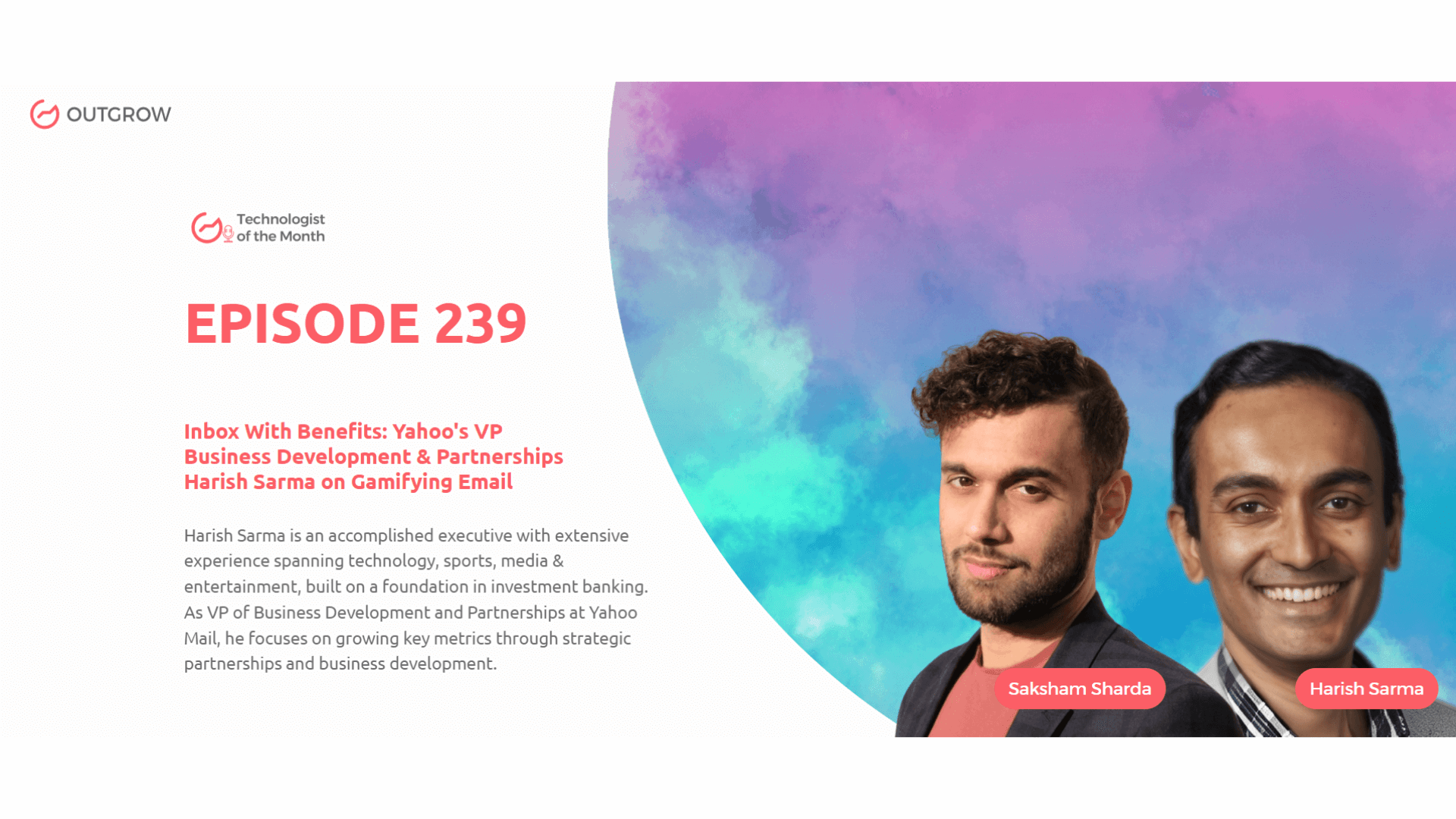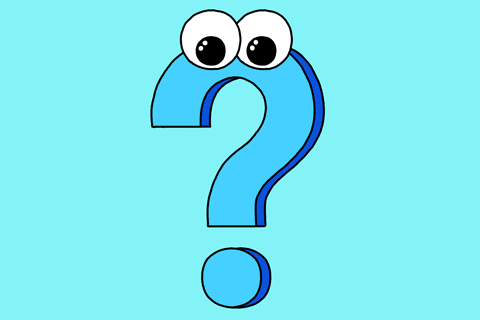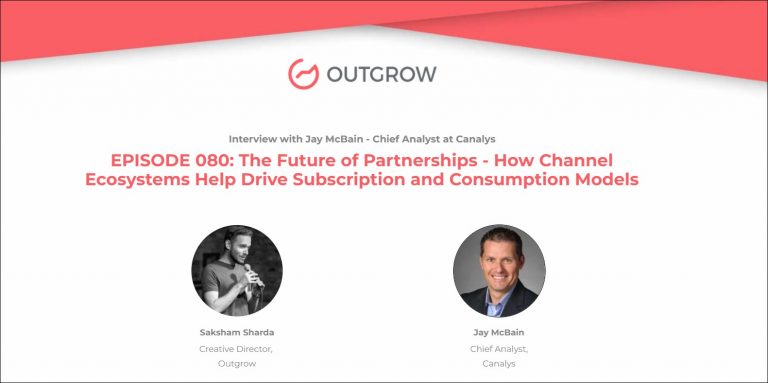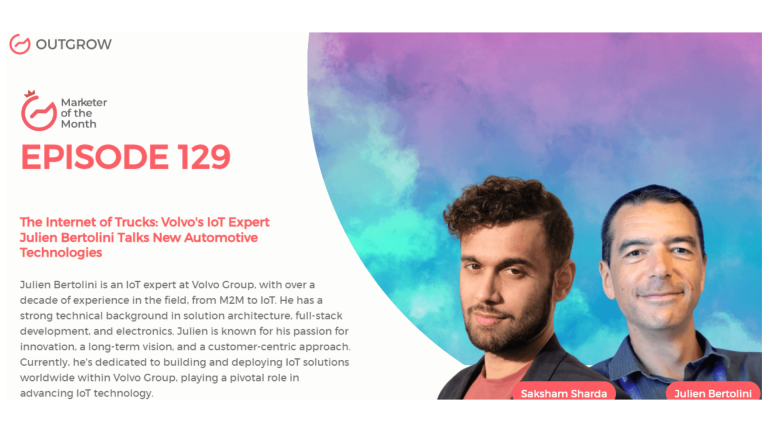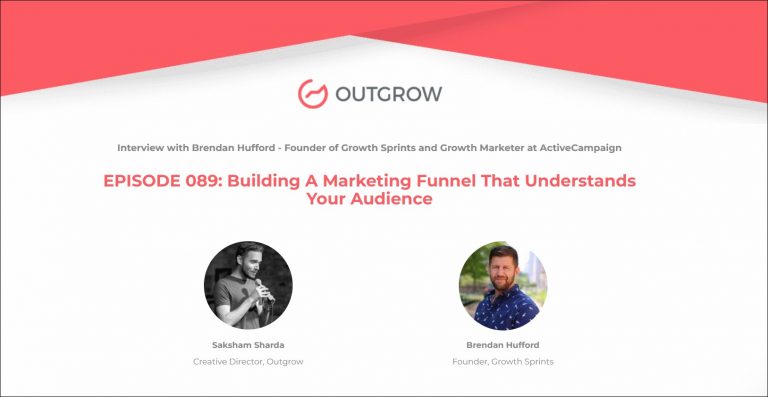EPISODE 239: Marketer of the Month Podcast with Harish Sarma
Table of Contents
Hey there! Welcome to the Marketer Of The Month blog!
We recently interviewed Harish Sarma for our monthly podcast – ‘Marketer of the Month’! We had some amazing, insightful conversations with Harish, and here’s what we discussed about-
1. Yahoo Mail’s revolutionary Catchup feature for inbox management
2. The shift from TikTok to Yahoo Mail leadership
3. How consumer behavior changed content consumption forever
4. Partnership strategies for explosive platform growth
5. Interoperability across Gmail, Outlook, and Yahoo Mail
6. Future of broadcasters and legacy media adaptation
About our host:
Dr. Saksham Sharda is the Chief Information Officer at Outgrow.co He specializes in data collection, analysis, filtering, and transfer by means of widgets and applets. Interactive, cultural, and trending widgets designed by him have been featured on TrendHunter, Alibaba, ProductHunt, New York Marketing Association, FactoryBerlin, Digimarcon Silicon Valley, and at The European Affiliate Summit.
About our guest:
Harish Sarma is an accomplished executive with extensive experience spanning technology, sports, media & entertainment, built on a foundation in investment banking. As VP of Business Development and Partnerships at Yahoo Mail, he focuses on growing key metrics through strategic partnerships and business development.
Inbox With Benefits: Yahoo’s VP Business Development & Partnerships Harish Sarma on Gamifying Email
The Intro!
Saksham Sharda: Hi, everyone. Welcome to another episode of Outgrow’s Marketer of the Month. I’m your host, Dr. Saksham Sharda, and I’m the creative director at Outgrow. co. And for this month we are going to interview Harish Sarma, who is the VP Business Development and Partnerships at Yahoo Mail.
Harish Sarma: Great to be here. Thank you.
Don’t have time to read? No problem, just watch the Podcast!
Challenge yourself with this trivia about the exciting topics Harish Sarma covered in the podcast.
Or you can just listen to it on Spotify!
The Rapid Fire Round!
Saksham Sharda: Okay, let’s start with the rapid-fire round, just to break the ice. Sure. The first question is, at what age do you want to retire?
Harish Sarma: It’s an interesting question. I feel like I have a love-hate relationship with the concept of retirement. I think I’m going to probably find something or the other to keep myself busy. I’m probably gonna switch into some version of the next phase of my career, whether that’s as an investor or as somebody who’s going to take an active role in making bets in the sector that I’m in. I will probably spend my time somewhere in the world of sports media or entertainment. The short answer would probably be never.
Saksham Sharda: One word or one sentence with a rapid formula. How long does it take you to get ready in the mornings?
Harish Sarma: I can get ready in 20 minutes.
Saksham Sharda: Favorite color.
Harish Sarma: Blue.
Saksham Sharda: What time of day are you most inspired?
Harish Sarma: Oh, 2:00 AM
Saksham Sharda: How many hours of sleep can you survive on?
Harish Sarma: I’m averaging five.
Saksham Sharda: How do you relax?
Harish Sarma: I love content.
Saksham Sharda: How many cups of coffee do you drink per day? Jesus.
Harish Sarma: Two on a bad day, ideally, one or none.
Saksham Sharda: A habit of yours that you hate
Harish Sarma: Procrastination.
Saksham Sharda: The most valuable skill you’ve learned in life.
Harish Sarma: You have to start doing the things you need to do now.
Saksham Sharda: An early riser or a night owl?
Harish Sarma: I’m a night owl.
Saksham Sharda: One-word description of your leadership style.
Harish Sarma: Trust.
Saksham Sharda: Coffee or tea to kickstart your day.
Harish Sarma: Tea.
Saksham Sharda: Top priority in your daily schedule.
Harish Sarma: Identify the three things that are gonna be the most impactful
Saksham Sharda: Ideal vacation spot for relaxation.
Harish Sarma: Actually, it’s a combination. Nature, part of a city, and then something for relaxation.
Saksham Sharda: Key factor for maintaining a work-life balance.
Harish Sarma: Finding the moments in your day where you have to take care of the things that need to be taken care of, but actually not let the world around you overwhelm you.
The Big Questions!
Saksham Sharda: Alright. That’s the end of the rapid fire. Yep. Now we’ll go on to the longer questions, which you can answer with as much time and ease as you like.
Harish Sarma: Yeah.
Saksham Sharda: So let’s talk a bit about your background. During your time at TikTok, you witnessed explosive global growth and changing content consumption patterns. How did you adapt partnership strategies to keep pace with such a rapid platform evolution?
Harish Sarma: Yeah, I’d say look, one of the most interesting things about when you are in the content space, specifically the trends that you personally perceive, can lag reality by a lot. What you end up doing a lot when you are at a place like TikTok in those early days is educating rights holders, publishers, most of the ecosystem, that the consumer has changed and the consumer’s preferences have evolved. The consumer’s showing behaviors that are completely different than what you have probably been doing. You, the rights holder, you, the, you know, broadcaster, you, the linear platform have been doing for the better part of maybe in some cases 50 to 70 years. That’s a hard conversation to have, right? Because the innovation and the pace of innovation have kept bringing new things and new areas, whether that’s VR, whether that’s MR, or XR. And so there is a lot of skepticism about what is new and whether that new thing is actually going to stay new and it’s going to be novel and then disappear, or is it actually going to stick. And so I’d say the difference was really showing the pace of that innovation and that pace of that adoption and the pace and the shift of that consumer behavior. If you juxtapose that with what’s really happening in the linear TV space, it was very clear, right, that these two things could exist side by side. They did not have to be seen as competitive with one another. And so that was an element that really, I’d say, changed the conversation. And you see it now very, very commonly. You see lots of broadcasters, lots of rights holders that are in both places. They have their presence right, on their own platforms, and they also exist in these, let’s call them third spaces. And so for me it was the journey to sort of tell that story, but really be able to do so and back it with data.
Saksham Sharda: And what made you make that shift from TikTok to Yahoo?
Harish Sarma: I think the opportunity to come to this platform, a storied brand at the cusp of a major turnaround was immensely intriguing for someone who had watched the Yahoo! story unfold over many years. I don’t feel like we have really had a chance to see what Yahoo Mail, for example, specifically can deliver in terms of a purely consumer facing solution. Like most people, I am a heavy user of email, and the first time I thought about this opportunity, it felt very personal to be able to shape its future. When you think about content or platforms, TikTok is an example of one, YouTube is another. A number of end users may feel “this is entertaining”, but it may not be furthering my goals in life. So there’s a challenge with utility. Email is the complete opposite of that. Email is arguably one of the highest utility platforms that exists. But the experience around email leaves a lot to be desired. And so I sort of look at these as diametrically opposed poles: One is high engagement, high enjoyment, which is content. And then email, which is extremely high utility and unfortunately pretty low on joy. And so imagine if you could actually insert a little bit of joy into the process of email. Even a 5% improvement, I think, will be meaningful in terms of how much time we commit to this platform. That opportunity, that challenge, is pretty exciting.
Saksham Sharda: Alright, let’s go. Tell us more about your role at Yahoo Mail and the evolution that the brand is undergoing at the moment.
Harish Sarma: So, Yahoo as a brand is not unfamiliar. It’s been around for 30 years, and so there’s tremendous brand awareness for what Yahoo is. I think what we’re going through right now is what we would term as a renaissance. It’s a chance to rethink all of our product surfaces across the board. I’m particularly focused on mail specifically, and that’s because mail itself has not really seen the depths of innovation that a lot of other products have received for the length of time that it’s been around. What’s really interesting about my role, and specifically Yahoo Mail, is that I get to connect what happens vis-à-vis the core product and how that links to external services that meaningfully enhance the experience. How can partners integrate with the inbox in a way that feels more natural and for the end consumer, how do we actually improve their experience so that it doesn’t feel like a chore? We believe the consumer’s inbox needs to be treated very differently than it has so far, and we believe that we are going to be able to launch new features that differentiate the plain vanilla email interface that most users have resigned themselves to.
Saksham Sharda: Email’s been the same for 30 years. How are you innovating with email?
Harish Sarma: Yeah, email exactly as you said, has been largely the same list view experience for most people. I’d say the number one challenge that most folks will admit to is that they are overwhelmed by the sheer volume of email. And so ultimately their ability to be effective in what they do on a day-to-day basis is directly limited by the quantum of email. We saw that problem and felt this is an opportunity to do something really different. Our goal was to come up with a product solution that addresses this very challenge. We then created a version of what I would call “email triage”. The product is called Catchup. And in very simple terms, you start out with your inbox, which is filled with a whole host of emails, you tap the catch-up button, and it immediately brings you into a forced view of the top email, but just that, and everything else is sort of grayed out in a gradient. The idea is you have two options only. And so it’s a game-like interface where we say, Do you want to keep this email or do you want to delete it? Just those two options, and you are free to click into it, scroll through, and make a decision. By doing this, we don’t make you make a really huge commitment. We don’t make you move in and archive it or flag it or do a whole host of other things. We force you to just make a simple decision: is this worth engaging with or not? And if it’s not worth engaging with, it takes a microsecond to make that decision. What you find is that this feature immediately starts to alleviate that burden and that you felt when you got to your inbox. At the end, we tell you how many emails you reviewed and how much time it took. You are then left with only the emails in your inbox that actually matter. If everybody could start their day with some variant of this – just the things they need to action, we think it would make a huge difference for a lot of folks. Catch Up has been an innovation that we pioneered is helping to win converts who now think very differently about the Yahoo Mail client.
Saksham Sharda: Email remains one of the most enduring digital communication platforms. How are you leveraging partnerships at Yahoo to evolve email beyond traditional messaging into a more comprehensive user experience?
Harish Sarma: Yeah. I’d say the most interesting thing that probably a lot of folks miss, right, is that the concept of partnerships is always seen as a one-to-one relationship. I think what I think is most interesting to think about is actually a one-to-many relationship. We do this with the Yahoo Mail client that allows any user to enjoy every new feature that we release across every email domain that they may be using. This means that at Yahoo, our goal is to build interoperability with your Gmail, Outlook, any other email domain that’s out there. What that means is your email account, which is something that stays with you for many, many years, doesn’t have to change to benefit from what we are building at Yahoo Mail and instead, the way you consume email can change. And the way you engage with the, oh, we lost it. Sorry.
Saksham Sharda: How do you, in these cases, balance introducing new features like these all through partnerships without overwhelming users who prefer simplicity?
Harish Sarma: Yeah, I’d say, you know, there are a number of studies that have been done where if you ask users what they want, they probably won’t be able to explain what they actually want. But there’s an idea of, “once I see it, I know”. And so just to give you an example, I mean, when we launched AI features for the first time, what we wanted to do was we wanted to take the complexity that exists in emails and really whittle them down into something that’s more bite-sized. Something that is more tangible, right? How do I take a really long email that came from a school district that has a bunch of different dates, a bunch of different information that pertains, probably to my child or me potentially? And I just don’t have the mental bandwidth to start to process each one of the blocks of text. Well, guess what, what if we did all that work? What if, what if we used AI to actually give you a really, really succinct way to interpret that email and then allow you to take actionable steps right at the top of that message?All of a sudden, this massive email that would’ve probably been opened then quickly pushed into unread, and then left for another day, actually gets dealt with. And you get to move on, and you get the satisfaction of having addressed a lot of the things. So this is just one simple example of how we’re leveraging AI in the inbox to actually improve the experience.
Saksham Sharda: Why should companies want to partner with Yahoo? Why should companies want to partner with Yahoo Mail? What’s your pitch to those attending IBC?
Harish Sarma: Yeah, I’d say email tends to be something that sits in the background for most people while also being an extremely personal aspect of people’s lives. At a place like IBC, you don’t see a lot of focus on what that experience is like yet. If you think about the relationship between marketers or broadcasters and their end users, where is it happening? If not on their own platforms, it’s happening in email. Every single marketer here sends promotional email, sends promotional collateral, actually tries to reach out to their consumers, and tries to get them to come back and consume again, try to come back and actually see what new offerings there are. That’s what email is. And, the connection point of the feedback loop element is something that doesn’t get discussed as much. And so the opportunity at IBC is actually to say, by the way, what if I could show you that there are ways in which you can meaningfully enhance that relationship that you’ve sort of taken for granted and assume doesn’t really have much to offer beyond what you already know. What turns out there’s a lot of, there’s a lot that we could be doing, and this is the opportunity to go do that.
Saksham Sharda: So you mentioned how email is a place where everything happens in the sense that you’re not publishing opportunities or reaching out, it’s where marketers are. But what is the future of email in a world where people just automate AI-generated and send AI-generated emails? Like, is that going to kill email? Is it going to, are you going to see an innovation that prevents such stuff from getting into people’s inboxes?
Harish Sarma: Yeah, I think, I think that’s a bit of a dystopian view of email. I think the death of email has been roundly predicted for at least two decades. Something tells me that there’s a lot more persistence with email for very, very specific reasons. If you think about email, there aren’t many moments in your life when you are signing up for an email. There are very specific life moments where you may get an email that could be tied to a specific stage of life such as going to school or starting to apply for jobs. There are a bunch of very specific moments when email becomes a pretty important facet in your life, and then it stays with you. And that staying with you bit is really identity. And at the end of the day, your inbox is a version of your identity. It is like a passport. And if you think about the value of a passport, no one would ever describe it as something that AI could effectively do away with or dispense with. Why? Because the idea of email’s value is yes, utility, but more than that, I think it’s actually your external digital identity.
Saksham Sharda: And so what specific metrics or KPIs do you focus on, if any?
Harish Sarma: Definitely focus on metrics. DAU, which is daily active user growth, is an outcome metric. And the idea of it is that you have a bunch of inputs that will determine that outcome. So when, if you are tracking DAU from a partnership to a partnership basis, you’re actually seeing what the sum total of each one of the things you are doing, how they actually culminate in an outcome within the actual platform. For me, that is the north star metric of note.
Saksham Sharda: And how do you then balance short-term revenue gains with long-term strategic value when negotiating partnership terms, for instance?
Harish Sarma: I think the concept of winning in a negotiation is a very odd and actually a challenging construct. Because nobody in a negotiation actually comes away feeling great. If they feel at some level you may have won, as they say, you may have won the deal point, but you did not win the actual outcome. The most valuable thing that you can get out of a partnership is that whatever you’ve agreed upon happens to be the template. But the reality is that you’re going to deliver an outcome that’s multiples on that outcome that you’ve actually agreed upon. It becomes the template for, and the foil for, what you actually do together. And so, for me, the most interesting aspect of that is how do you ensure that your counterparty is deeply incentivized to invest in your relationship? Because you’re not the only partnership that they’re striking, they’re striking several partnerships. How are they actually allocating resources within their organization to then actually optimize your efforts? Because if they do that, it basically means, irrespective of what the economics are, you’re going to win out together, and that’s the best outcome.
Saksham Sharda: So with the rise of creative economy platforms and direct-to-consumer brands, how has your approach to business development evolved to accommodate these new market players?
Harish Sarma: So the interesting thing is, right, we’ve had different categories of users and frankly, businesses for a long time. You split between solopreneurs all the way through to SMBs, and then you scale that into enterprise creators have just effectively become a new proxy for the SMB. And so when you think about them, you cannot treat them like the SMB category, but they are effectively analogous to, and so how do you actually create solutions for them that actually will appeal to them? In my, my role here at, at Yahoo Mail, we really are thinking about how does that creator’s experience in terms of managing not just their life, but their business, which effectively is intertwined and tied to work-life balance, how those things connected in a way in which we can meaningfully improve their relationship and their outcomes. Their relationship with their end user, which happens to be all their fans and all their followers, and ultimately all the brands and all the marketers that are looking to engage with them. How do we become an integral piece of that puzzle, and how do we meaningfully change that? So we have to evolve with the evolving landscape.
Saksham Sharda: So what other challenges do you face when working with creators versus traditional corporate partners?
Harish Sarma: Creators are tremendously resource-constrained, more than probably anybody else that you can imagine. There’s nothing quite like having someone who’s actually standing up an entire business on their own and actually betting on themselves. But what’s great about it is it is also an opportunity now for folks like Yahoo to actually leverage not just our platform, but also leverage new tools. You mentioned artificial intelligence previously. We embedded a tremendous number of artificial intelligence tools within our product set to actually ensure that you are optimizing the best outcomes you can as a creator. And you’re not just constantly stuck in the mundane and the admin aspects of being a creator. You can actually, hopefully, spend most of your time being creative.
Saksham Sharda: So, with the growing importance of personalization and algorithmic content delivery, how do you ensure partnership content integrates seamlessly with platform recommendation systems?
Harish Sarma: So what’s interesting about a lot of the recommendations is everything that’s happening is tied in some way, in some respect, to trends. Trends that are either prevailing or the outcomes that folks are expecting. So you have in this particular case, a lot of what we do is serve as the platform that allows different, whether that’s brands, whether that’s creators or, and anybody who is part of the ecosystem to participate, but actually use us as a conduit to either get to their end consumer or produce the creative that actually leverages those trends and those those outcomes. Think of us really as the place where it all happens. And it’s either happening in your inbox or it’s happening on the way to your inbox, but the idea of what, and what’s trending and why it’s trending, we don’t have to frankly take a position on that because it actually, either way, it’s gonna happen, it’s gonna end up in your inbox.
Saksham Sharda: The shift from traditional media consumption to short-form interactive content has been dramatic. How do you identify content partners who can authentically engage with younger demographics?
Harish Sarma: Yeah. The beauty about this is that when you are using Yahoo Mail, you actually welcome both sides. Traditional media and new media or social media all need an endpoint, which it’s, if you think about where the audience is, the audience usually sits on your own platforms. So if you are a broadcaster, if you are a rights holder, you have owned platforms that the users are on, and customers are on at the same time. If they’re not there, you’re concerned because they’re not on your own platforms. What people forget a lot of times is that the other place that they are, which is not with you and not with social media, is actually on email. And so they’re spending a lot of time actually organizing their life and managing all the things, and how they want to allocate their time. And a lot of that is happening in the inbox. And so, we look at this as really an opportunity to embrace both of these elements and frankly provide the best inbox experience.
Saksham Sharda: Let’s talk about AI then. Artificial intelligence is reshaping content creation and distribution. How are you incorporating AI-driven insights into your partnership strategy and content planning processes?
Harish Sarma: So AI is actually turning out to be a pretty important component of the process of your inbox. And so more specifically, the way you compose your emails, the way you start to think about responses, the way you actually automate a lot of the mundane aspects of managing your life. If you think about very, very basic things, like you need to follow up on something, or you did not receive a package, or you didn’t hear back from someone that you should have heard back from. A lot of these are elements that we actually can leverage AI to do that first cut. To write that first draft email allows you to focus on nuances and specifics.
Saksham Sharda: Just that one. What’s your view on how traditional legacy media studios and broadcasters should adapt to survive?
Harish Sarma: That’s a great question. I’d say adapt to survive is probably the only way any organization ultimately thrives in its outcomes. We on the mail side have seen this as actually an opportunity to, to really take, for example, what is largely a, a low innovation, you know backdrop and actually meaningfully change the conversation with the end consumer. I actually think that approach is no different for broadcasters in this space. I think there’s a danger of kind of assuming that it’s somebody else’s role to have that relationship and to build that relationship and to innovate for that end consumer. I think that’s a dangerous game to play because ultimately then your goals and your outcomes will be in the hands of another platform or a different venue for this outcome. I think the idea of a rights holder thinking differently or broadcasting or thinking differently about that relationship and innovating directly to speak to that end consumer is actually in your best interests. And thankfully and conveniently, email tends to be a pretty good conduit to do that.
Saksham Sharda: Have you ever reached a zero email inbox?
Harish Sarma: I think on two occasions in my entire life. And it was quickly, you know, surpassed and eliminated by the next morning.
Saksham Sharda: Tell us a bit about your daily schedule. How much of it is meetings? How much of it is emails, how much of it is anything else?
Harish Sarma: Yeah. I try to spend the morning, like the early morning, usually between eight and 11, to really, really focus on a combination of planning, reading, and preparation for what I believe is going to be a pretty long day. And a big part of that also is ensuring that I am going to focus on the things that really matter and the things that really need my deep attention. I get to them right as the day starts. So I try not to schedule a lot in that slot. I then go into meeting mayhem, which can, you know, which can go anywhere till six or 7:00 PM, sometimes unfortunately is sometimes longer. And then I usually spend some time with my kids and the family. And I try to maximize that time and really protect it. It’s important to me. And then I usually return for round two, which is usually my most productive. And you know, while I have a love-hate relationship with that sometimes, but it turns out I can be extremely productive at those really odd hours. And I think you have to just find those moments when you could be your best.
Saksham Sharda: Alright. So the last question for you is of a personal kind. Yeah. What would you be doing in your life, if not this?
Harish Sarma: What would I be doing in my life, if not this? I’d probably end up picking hobbies that are of interest to me, but I don’t necessarily know that I would be particularly good at building a career out of them. I probably would travel a whole lot and find a way to combine traveling with a job that required me to travel a lot, just because it would help me combine those two things.
Let’s Conclude!
Saksham Sharda: Thanks, everyone for joining us for this month’s episode of Outgrow’s Marketer of the Month. That was Harish Sarma, who is the VP Business Development and Partnerships at Yahoo Mail.
Harish Sarma: Great to be here. Thank you.
Saksham Sharda: Check out the website for more details and we’ll see you once again next month with another marketer of the month.

I am a Digital Marketing Enthusiast with a passion for optimizing content and paid marketing strategies. Continuously seeking innovative approaches to boost ROI and engagement at Outgrow.

